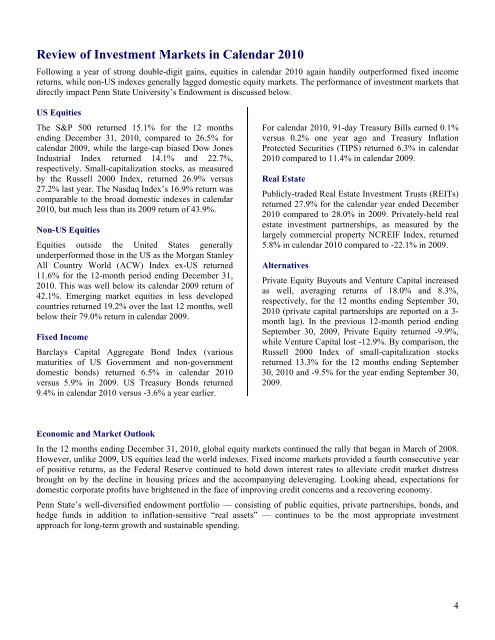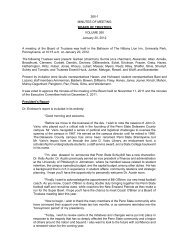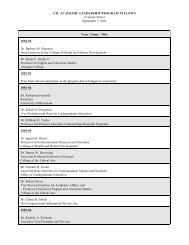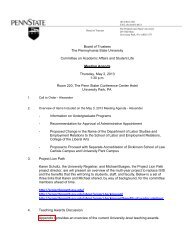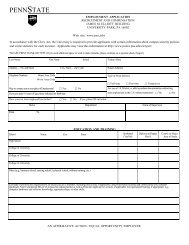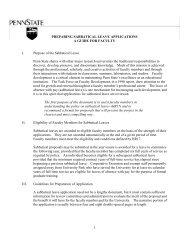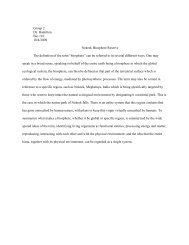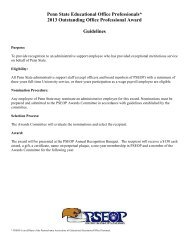Endowment & Similar Funds - Penn State University
Endowment & Similar Funds - Penn State University
Endowment & Similar Funds - Penn State University
You also want an ePaper? Increase the reach of your titles
YUMPU automatically turns print PDFs into web optimized ePapers that Google loves.
Review of Investment Markets in Calendar 2010<br />
Following a year of strong double-digit gains, equities in calendar 2010 again handily outperformed fixed income<br />
returns, while non-US indexes generally lagged domestic equity markets. The performance of investment markets that<br />
directly impact <strong>Penn</strong> <strong>State</strong> <strong>University</strong>’s <strong>Endowment</strong> is discussed below.<br />
US Equities<br />
The S&P 500 returned 15.1% for the 12 months<br />
ending December 31, 2010, compared to 26.5% for<br />
calendar 2009, while the large-cap biased Dow Jones<br />
Industrial Index returned 14.1% and 22.7%,<br />
respectively. Small-capitalization stocks, as measured<br />
by the Russell 2000 Index, returned 26.9% versus<br />
27.2% last year. The Nasdaq Index’s 16.9% return was<br />
comparable to the broad domestic indexes in calendar<br />
2010, but much less than its 2009 return of 43.9%.<br />
Non-US Equities<br />
Equities outside the United <strong>State</strong>s generally<br />
underperformed those in the US as the Morgan Stanley<br />
All Country World (ACW) Index ex-US returned<br />
11.6% for the 12-month period ending December 31,<br />
2010. This was well below its calendar 2009 return of<br />
42.1%. Emerging market equities in less developed<br />
countries returned 19.2% over the last 12 months, well<br />
below their 79.0% return in calendar 2009.<br />
Fixed Income<br />
Barclays Capital Aggregate Bond Index (various<br />
maturities of US Government and non-government<br />
domestic bonds) returned 6.5% in calendar 2010<br />
versus 5.9% in 2009. US Treasury Bonds returned<br />
9.4% in calendar 2010 versus -3.6% a year earlier.<br />
For calendar 2010, 91-day Treasury Bills earned 0.1%<br />
versus 0.2% one year ago and Treasury Inflation<br />
Protected Securities (TIPS) returned 6.3% in calendar<br />
2010 compared to 11.4% in calendar 2009.<br />
Real Estate<br />
Publicly-traded Real Estate Investment Trusts (REITs)<br />
returned 27.9% for the calendar year ended December<br />
2010 compared to 28.0% in 2009. Privately-held real<br />
estate investment partnerships, as measured by the<br />
largely commercial property NCREIF Index, returned<br />
5.8% in calendar 2010 compared to -22.1% in 2009.<br />
Alternatives<br />
Private Equity Buyouts and Venture Capital increased<br />
as well, averaging returns of 18.0% and 8.3%,<br />
respectively, for the 12 months ending September 30,<br />
2010 (private capital partnerships are reported on a 3-<br />
month lag). In the previous 12-month period ending<br />
September 30, 2009, Private Equity returned -9.9%,<br />
while Venture Capital lost -12.9%. By comparison, the<br />
Russell 2000 Index of small-capitalization stocks<br />
returned 13.3% for the 12 months ending September<br />
30, 2010 and -9.5% for the year ending September 30,<br />
2009.<br />
Economic and Market Outlook<br />
In the 12 months ending December 31, 2010, global equity markets continued the rally that began in March of 2008.<br />
However, unlike 2009, US equities lead the world indexes. Fixed income markets provided a fourth consecutive year<br />
of positive returns, as the Federal Reserve continued to hold down interest rates to alleviate credit market distress<br />
brought on by the decline in housing prices and the accompanying deleveraging. Looking ahead, expectations for<br />
domestic corporate profits have brightened in the face of improving credit concerns and a recovering economy.<br />
<strong>Penn</strong> <strong>State</strong>’s well-diversified endowment portfolio — consisting of public equities, private partnerships, bonds, and<br />
hedge funds in addition to inflation-sensitive “real assets” — continues to be the most appropriate investment<br />
approach for long-term growth and sustainable spending.<br />
4


